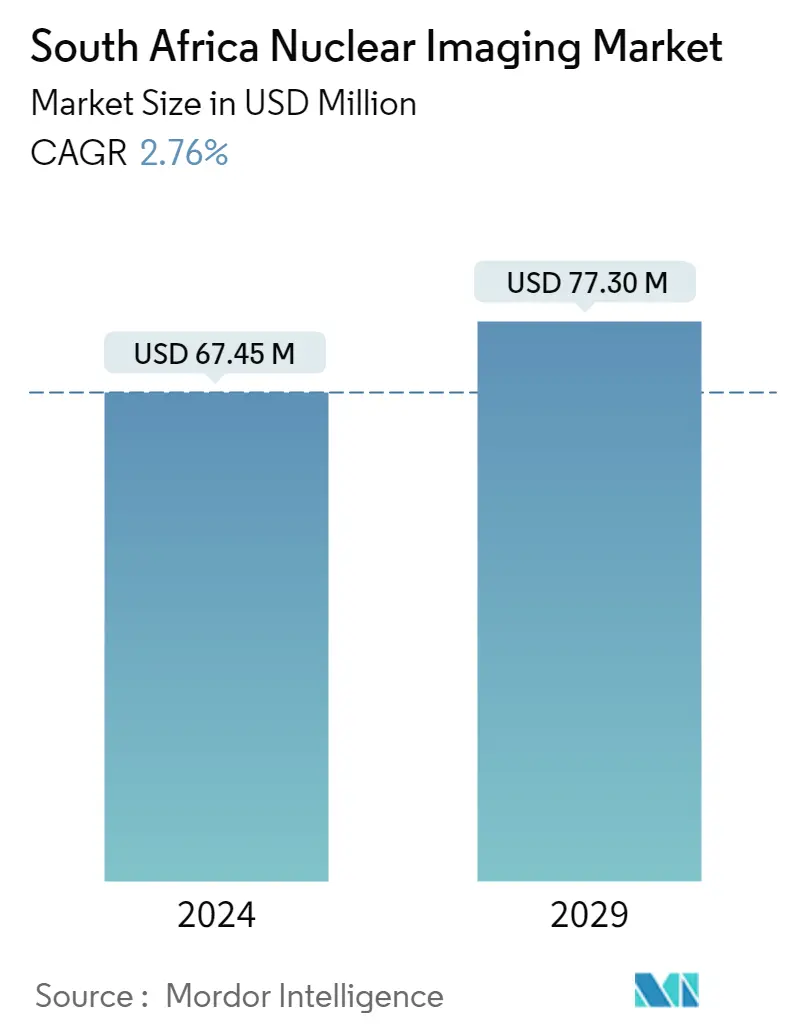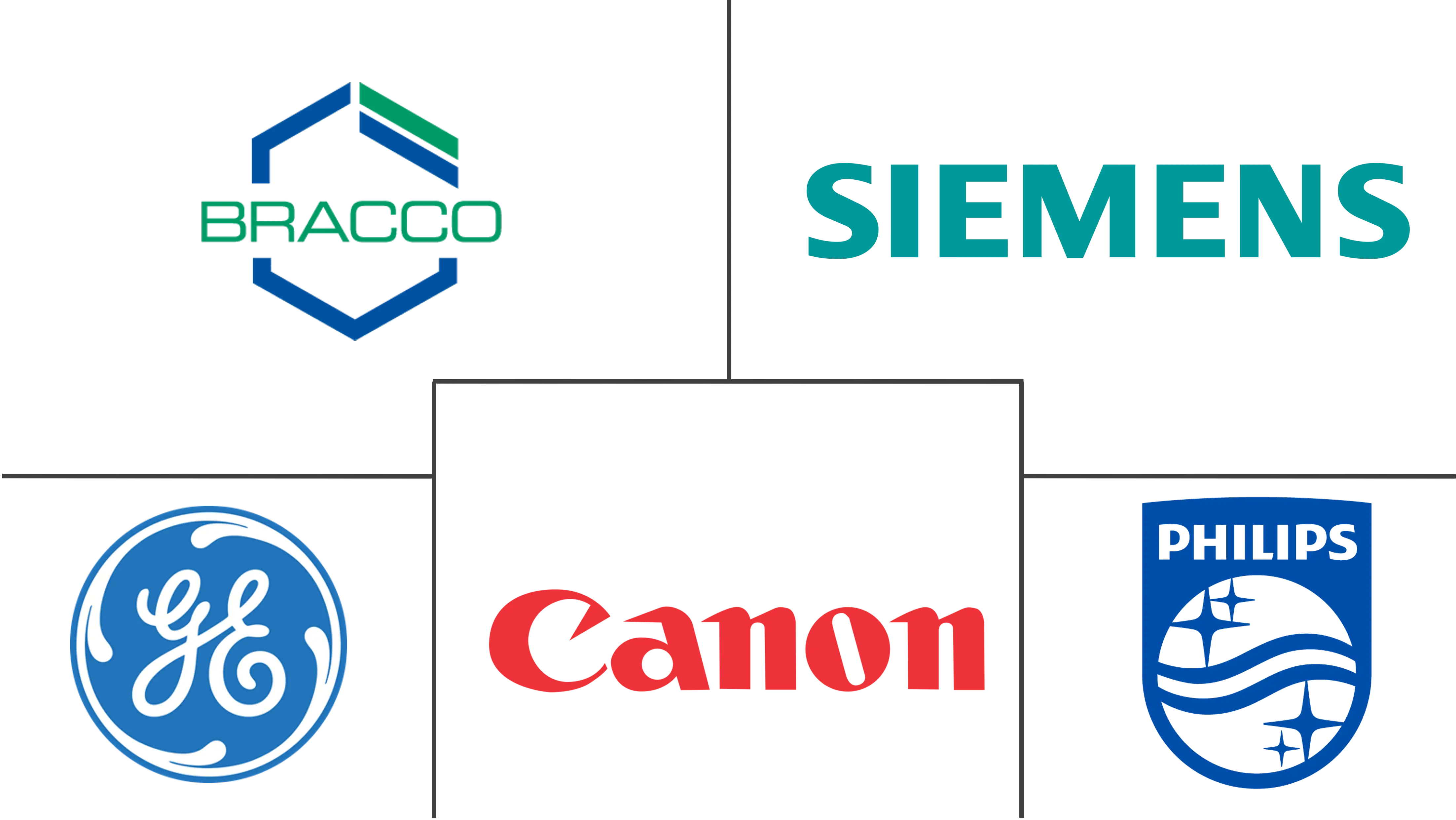Market Size of South Africa Nuclear Imaging Industry

| Study Period | 2019 - 2029 |
| Base Year For Estimation | 2023 |
| Market Size (2024) | USD 67.45 Million |
| Market Size (2029) | USD 77.30 Million |
| CAGR (2024 - 2029) | 2.76 % |
| Market Concentration | Medium |
Major Players
*Disclaimer: Major Players sorted in no particular order |
South Africa Nuclear Imaging Market Analysis
The South Africa Nuclear Imaging Market size is estimated at USD 67.45 million in 2024, and is expected to reach USD 77.30 million by 2029, growing at a CAGR of 2.76% during the forecast period (2024-2029).
According to a study titled 'Nuclear Medicine Operations in the Times of COVID-19: Strategies, Precautions, and Experiences' published in the Journal of Nuclear Medicine in May 2020, the nuclear medicine staff in the country have been instructed to have refresher courses on infection control management and basic emergency management. South Africa saw a reduction in the clinical service for nonurgent scans, and inpatient and urgent outpatient studies, especially in oncology. The country had an inbuilt supply of many radioisotopes, as the country has nuclear reactors from Jubilant Pharmova and therefore was not affected by shortages of radiopharmaceuticals, but the country was dependent on overseas supply for many kits and reagents and the shutdown of airline flights have caused shortages for those kits and reagents.
However, COVID-19 has opened many opportunities for the market players in the industry to identify and tap the market and expand their operations to generate revenue for their company. For instance, In 2020, Jubliant Pharmova, one of the provoders of radiopharmaceuticals, started its own office in South Africa as part of its long-term plan of going direct to market with its own sales team. This will bring investment in the South African economy thus improving the country's economic condition.
Nuclear imaging is hugely capable of diagnosing cancer and cardiac diseases. Nuclear medicine scans ( also known as nuclear imaging, radionuclide imaging, and nuclear scans) can help doctors find tumors and see how much cancer has spread in the body. Cardiac nuclear medicine imaging evaluates the heart for coronary artery disease and cardiomyopathy (diseases of the heart muscle). It also may be used to help determine whether the heart has been damaged by chemotherapy or radiotherapy. Additionally, as per the 2021 data from International Society for Optics and Photonics, South Africa is rapidly acquiring high-tech medical imaging equipment such as multi-slice helical computed tomography (CT) scanners, as well as hybrid imaging technologies like combining single photon emission computed tomography and positron emission tomography with CT. This adoption of nuclear imaging equipment is expected to boost the market growth in South Africa over the forecast period.
South Africa Nuclear Imaging Industry Segmentation
As per the scope of this report, Nuclear medicine imaging procedures are non-invasive, with the exception of intravenous injections, and are usually painless medical tests that help physicians diagnose and evaluate medical conditions. These imaging scans use radioactive materials called radiopharmaceuticals or radiotracers. These radiopharmaceuticals are used in diagnosis and therapeutics. South Africa Nuclear Imaging Market is segmented by Product (Equipment, Diagnostic Radioisotopes), and Application (SPECT Applications, PET Applications). The report offers the value (in USD million) for the above segments.
| By Product | ||||
| Equipment | ||||
|
| By Application | ||||||
| ||||||
|
South Africa Nuclear Imaging Market Size Summary
The nuclear imaging market in South Africa is poised for growth, driven by advancements in medical technology and strategic industry developments. The market is characterized by the increasing adoption of high-tech medical imaging equipment, such as multi-slice helical CT scanners and hybrid imaging technologies, which are enhancing diagnostic capabilities for cancer and cardiac diseases. The country's robust infrastructure, including nuclear reactors and a strong supply of radioisotopes, supports the market's expansion. Despite challenges posed by the COVID-19 pandemic, such as shortages in overseas supplies, the industry has seen opportunities for growth, with companies like Jubilant Pharmova establishing a direct market presence in South Africa. This strategic move is expected to bolster the local economy and enhance the availability of radiopharmaceuticals.
The competitive landscape of the South African nuclear imaging market is dominated by major players such as Bracco Imaging SpA, Curium, Cardinal Health Inc., Koninklijke Philips NV, GE Healthcare, and Siemens Healthineers. These companies hold significant market shares and are actively involved in partnerships and collaborations to expand their reach and capabilities. Notable collaborations include agreements for the commercialization of advanced imaging products and the establishment of cyclotron-based radiopharmacy businesses. Additionally, South Africa's position as a leading producer of medical nuclear isotopes and its international collaborations in nuclear medicine research further contribute to the market's growth prospects. As the demand for advanced diagnostic tools continues to rise, the nuclear imaging market in South Africa is expected to experience sustained expansion over the forecast period.
South Africa Nuclear Imaging Market Size - Table of Contents
-
1. MARKET DYNAMICS
-
1.1 Market Overview
-
1.2 Market Drivers
-
1.2.1 Increasing Prevalence of Cancer and Cardiac Disorders
-
1.2.2 Technological Advancements in Nuclear Imaging
-
-
1.3 Market Restraints
-
1.3.1 Stringent Regulations
-
-
1.4 Porter's Five Forces Analysis
-
1.4.1 Threat of New Entrants
-
1.4.2 Bargaining Power of Buyers/Consumers
-
1.4.3 Bargaining Power of Suppliers
-
1.4.4 Threat of Substitute Products
-
1.4.5 Intensity of Competitive Rivalry
-
-
-
2. MARKET SEGMENTATION (Market Size by Value - USD million)
-
2.1 By Product
-
2.1.1 Equipment
-
2.1.2 Diagnostic Radioisotope
-
2.1.2.1 SPECT Radioisotopes
-
2.1.2.2 PET Radioisotopes
-
-
-
2.2 By Application
-
2.2.1 SPECT Applications
-
2.2.1.1 Cardiology
-
2.2.1.2 Neurology
-
2.2.1.3 Thyroid
-
2.2.1.4 Other SPECT Applications
-
-
2.2.2 PET Applications
-
2.2.2.1 Oncology
-
2.2.2.2 Cardiology
-
2.2.2.3 Neurology
-
2.2.2.4 Other PET Applications
-
-
-
South Africa Nuclear Imaging Market Size FAQs
How big is the South Africa Nuclear Imaging Market?
The South Africa Nuclear Imaging Market size is expected to reach USD 67.45 million in 2024 and grow at a CAGR of 2.76% to reach USD 77.30 million by 2029.
What is the current South Africa Nuclear Imaging Market size?
In 2024, the South Africa Nuclear Imaging Market size is expected to reach USD 67.45 million.

